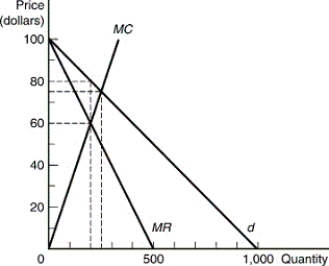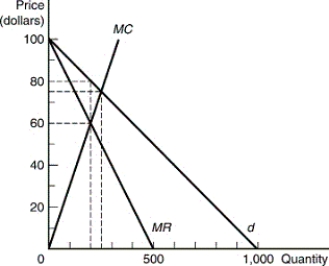A) $500.
B) $1,000.
C) $1,600.
D) $2,000.
E) $2,500.
Correct Answer

verified
D
Correct Answer
verified
Multiple Choice
Duopolists A and B face the following demand curves: QA = 100 - 2PA + 2PB and QB = 100 - 2PB + 2PA.If both firms have zero marginal cost,what are the profit-maximizing prices and quantities?
A) PA = 100, QA = 60, PB = 80, QB = 140.
B) PA = 25, QA = 100, PB = 25, QB = 100.
C) PA = 50, QA = 80, PB = 40, QB = 120.
D) PA = 50, QA = 100, PB = 50, QB = 100.
E) PA = 60, QA = 60, PB = 40, QB = 140.
Correct Answer

verified
Correct Answer
verified
Multiple Choice
Glyde Air Fresheners is the dominant firm in the solid room aromatizer industry,which has a total market demand given by Q = 80 - 2P.Glyde has competition from a fringe of four small firms that produce where their individual marginal costs equal the market price.The fringe firms each have total costs given by TCi = 10Qi + 2Q2i .If Glyde's total costs are given by TCG = 100 + 6QG,what is Glyde's maximum profit?
A) $148.
B) $184.
C) $240.
D) $332.
E) $362.
Correct Answer

verified
Correct Answer
verified
Multiple Choice
In the United States most cartels were declared illegal by the:
A) Sherman Antitrust Act.
B) Interstate Commerce Commission.
C) Supreme Court.
D) Constitution.
E) Declaration of Independence.
Correct Answer

verified
A
Correct Answer
verified
Multiple Choice
Suppose duopolists in the market for spring water share a market demand curve given by P = 50 - 0.02Q,where P is the price per gallon and Q is thousands of gallons of water per day.The marginal cost of producing water is near zero for both firms.If one firm acts as a first mover,the second firm will produce:
A) 0 gallons of water per day per firm.
B) 625 gallons of water per day.
C) 833 gallons of water per day.
D) 1,250 gallons of water per day.
E) 2,500 gallons of water per day.
Correct Answer

verified
Correct Answer
verified
Multiple Choice
The optimal output and price for the cartel shown in the accompanying diagram is: 
A) Q = 200 and P = $80.
B) Q = 260 and P = $60.
C) Q = 250 and P = $80.
D) Q = 500 and P = $75.
E) none of the above.
Correct Answer

verified
Correct Answer
verified
Multiple Choice
Oligopoly is the only market structure in which one finds:
A) barriers to entry.
B) competing brand names.
C) minimum average total cost pricing.
D) advertising.
E) firm interdependence.
Correct Answer

verified
Correct Answer
verified
Multiple Choice
The kinked demand model assumes firms will:
A) ignore the price increases of rivals.
B) follow the price decreases of rivals.
C) ignore all price changes of rivals.
D) follow all price changes of rivals.
E) a and b
Correct Answer

verified
Correct Answer
verified
Multiple Choice
What is the advantage to a particular firm of cheating on an otherwise effective cartel?
A) The industry can then act like a monopoly.
B) It decreases risk.
C) It enhances credibility.
D) It always pays in the short run and may pay in the long run.
E) It always pays in the long run and may pay in the short run.
Correct Answer

verified
Correct Answer
verified
Multiple Choice
Sticky prices are an outcome of the kinked demand model because:
A) firms in an oligopoly will collude to hold prices fixed.
B) marginal costs are constant in oligopolistic industries.
C) marginal costs can vary to some extent, but firms will have no incentive to change their prices in oligopolistic industries.
D) demand is perfectly elastic in oligopolistic industries.
E) firms will set price equal to marginal cost in oligopolistic industries.
Correct Answer

verified
Correct Answer
verified
Multiple Choice
Two local ready-mix cement manufacturers,Here and There,have combined demand given by Q = 105 - P.Their total costs are given by TCHere = 5QHere + 0.5Q2Here and TCThere = 5QThere + 0.5Q2There.If they cannot successfully collude and instead produce where the market price equals marginal cost,each firm's profits will be:
A) $111.11.
B) $222.22.
C) $333.33.
D) $444.44.
E) $555.55.
Correct Answer

verified
Correct Answer
verified
Multiple Choice
The price leadership strategy is most appropriate when a market is:
A) perfectly competitive.
B) monopolistic.
C) monopolistic competitive.
D) oligopolistic.
E) all of the above.
Correct Answer

verified
Correct Answer
verified
Multiple Choice
Glyde Air Fresheners is the dominant firm in the solid room aromatizer industry,which has a total market demand given by Q = 80 - 2P.Glyde has competition from a fringe of four small firms that produce where their individual marginal costs equal the market price.The fringe firms each have total costs given by TCi = 10Qi + 2Q2i.If Glyde's total costs are given by TCG = 100 + 6QG,what are the total profits of the fringe firms?
A) $32.
B) $64.
C) $96.
D) $128.
E) $160.
Correct Answer

verified
A
Correct Answer
verified
Multiple Choice
Suppose duopolists in the market for spring water share a market demand curve given by P = 50 - 0.02Q,where P is the price per gallon and Q is thousands of gallons of water per day.The marginal cost of producing water is near zero for both firms.If firm A produces zero,firm B's best response is producing:
A) 0 gallons of water per day.
B) 48 gallons of water per day.
C) 833 gallons of water per day.
D) 1,250 gallons of water per day.
E) 2,500 gallons of water per day.
Correct Answer

verified
Correct Answer
verified
Multiple Choice
Whopper Stoppers Inc.chooses a price for its sink stoppers,and other firms always charge the same price.Whopper Stoppers Inc.is:
A) colluding.
B) losing money in the long run.
C) threatening competitors.
D) a price leader.
E) preempting the competitors.
Correct Answer

verified
Correct Answer
verified
Multiple Choice
A cartel is:
A) the name for firms in any oligopoly market.
B) a collusive organization.
C) an oligopolist that competes with other oligopolists.
D) a group of firms using price leadership.
E) a group of firms using preemptive strategies.
Correct Answer

verified
Correct Answer
verified
Multiple Choice
If the market described in the accompanying diagram is dominated by a cartel,the loss in total surplus relative to perfectly competitive market conditions will be: 
A) $500.
B) $1,000.
C) $2,000.
D) $3,000.
E) $4,000.
Correct Answer

verified
Correct Answer
verified
Multiple Choice
If a cartel is working properly,its firms will likely be producing where (MCi is each firm i's marginal cost,MR is market marginal revenue,and P is price) :
A) MCi = MR.
B) MCi > MR.
C) MCi < MR.
D) P = MR.
E) P < MR.
Correct Answer

verified
Correct Answer
verified
Multiple Choice
While a cartel is holding together,its individual members' demand curves are likely to be:
A) significantly elastic.
B) significantly inelastic.
C) close to unitary in elasticity.
D) kinked.
E) upward-sloping.
Correct Answer

verified
Correct Answer
verified
Multiple Choice
Cartels can only exist:
A) in oligopoly markets.
B) when products are homogeneous.
C) when products are not homogeneous.
D) in countries where they are legal.
E) when demand curves are perfectly inelastic.
Correct Answer

verified
Correct Answer
verified
Showing 1 - 20 of 41
Related Exams